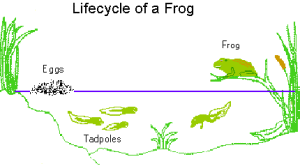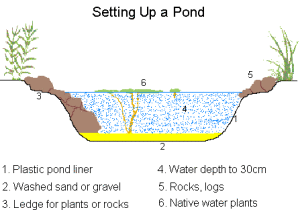Frogs in the Garden
Frogs are wonderfully diverse creatures. They can be found in environments ranging from deserts to snowfields and waterfalls. They cope with all kinds of weather extremes, but can they cope with environmental changes that we make?
What can you do to help frogs in your neighbourhood, and how can you encourage them into your backyard?
Frogs don’t live everywhere. Each kind of frog has specific requirements for all types of things, like water, temperature, humidity and even barometric pressure. Some have interesting habits like burrowing underground, or breeding only in still water.
Frogs need insects to eat, humidity, hiding places and a suitable place to breed. Grow lots of plants of various heights in your garden. Keep the yard well watered. Mulching the garden beds and keeping a compost heap will attract insects. Frogs love vegetable gardens and greenhouses. Avoid using garden chemicals, as frogs absorb chemicals through their skins easily and may eat poisoned insects.
It is illegal to move frogs and tadpoles off or onto your property and illegal to take frogs and tadpoles from the environment as pets or to stock your pond. In QLD, frogs can only be purchased by licensed breeders/pet shops and be kept with a valid licence issued by the Department of Environment and Science (DES). Click here for further information.
Life Cycle
 Male frogs call in the breeding season to attract a mate. Eggs are usually laid in or near water, and may be set in a sticky white froth or a clear gel. If conditions are right, they hatch within a few days.
Male frogs call in the breeding season to attract a mate. Eggs are usually laid in or near water, and may be set in a sticky white froth or a clear gel. If conditions are right, they hatch within a few days.
Tadpoles mainly feed on decaying plant matter. They gradually develop legs and lungs and metamorphose into frogs. Water quality and temperature, availabile food and competition with other tadpoles all affect their growth rate. This stage of life cycle can take up to ten weeks or more in warm weather. In winter, tadpoles may not grow at all.
When froglets emerge from the pond, they feed on small insects such as mosquitoes, vinegar flies and slaters. Larger frogs eat larger insects and other small creatures. frogs in turn are eaten by many predators, such as birds, fish turtles snakes and other frogs.
Setting Up a Pond
Above Ground Ponds
Any non-metallic clean container can be used. Tadpoles prefer shallow water with a large surface area. Toddlers’ “clamshell” wading pools are suitable.
Position
Tadpoles are very heat sensitive. A position receiving 75% shade for most of the day is best. Frogs call at night and can be quite loud, so don’t put a pond near a bedroom window.
Water
Water must be chlorine and chemical free. Stand tap water in sunlight for 5 days, so chlorine can dissipate. Don’t use chlorine neutralising drops. Keep spare chlorine free water on hand.
Water Plants
Native water plants such as nardoo or reeds, provide shelter, rest areas and food. They also help to balance the eco-system, and keep the water clean. Avoid noxious weeds such as water hyacinth and salvinia, which can choke waterways.
Mosquito Control
Pacific Blue-eyes, Pseudomugil signifer, native to the Brisbane region, eat mosquito larva, but not tadpoles. Keep 3 or 4 in a small pond and feed them once a week with fish food. Note, Gold fish are not compatible with frog habitat as they will eat frog eggs and tadpoles.
Access to the Water
Once tadpoles develop front legs, they need to be able to climb out of the water. Ground dwelling frogs particularly, need a rough slope they can climb easily, or they may drown. A slope can be provided by rocks or branches protruding from the water, or by floating water plants.
Feeding Tadpoles
Feed tadpoles boiled lettuce. Use unwanted outer dark green leaves from your green-grocer. Wash thoroughly to remove pesticides, then boil until soft (15-20 minutes). Boiled leaves may be conveniently stored in plastic ice cube trays and frozen ready for use.
Feed tadpoles as much food as they will eat every 1-3 days. Remove any remaining food before re-feeding. Too much food will foul the water; not enough and the tadpoles will eat each other. Boiled milk thistles, paw-paw leaves and thinly sliced zucchini may also be used for variety.
Native Plants for Frog Ponds
Outer & edges of pond
Alpinia caerulea – Native ginger
Gahnia sieberiana – Saw-leafed sedge
Themeda triandra – Kangaroo grass
Geitonoplesium – cymosum Scrambling lily
Melastoma affine – Blue tongue or native lasiandra
Banksia robur – Swamp banksia
Viola hederacea – Native violet
Lomandra hystrix – Mat rush
Lomandra longifolia – Long-leafed mat rush
Lygodium microphyllum – Climbing maiden hair
Philydrum lanuginosum – Frogsmouth
Persicaria strigosum – Smart weed
Persicaria attenuatum – Smart weed
Persicaria orientale – Smart weed
Ludwigia octovalvis – Native primrose
Cyperus exaltatus – Giant sedge
Phragmites australis – Common reed
Rhynchospora corymbosa
Histiopteris incisa – Bat’s wing fern
Blechnum indicum – Binung or water fern
Villarsia exaltata – Erect marsh flower
Juncus usitatus – Common rush
In pond
Ricciocarpus natans – Liverwort
Aponogeton elongatus
Brasenia schreberi – Watershield
Marsilea mutica – Nardoo
Nymphaea violacea – Native waterlily
Ottelia ovatifolia – Swamp lily
Nymphoides indica – Water snowflake
Potamogeton perfoliatus – Clasped pond weed
Cotula coronopifolia – Water buttons
Eriocaulon australe
Azolla species – Native fern
Triglochin procerum – Water ribbon
Native Plant Nurseries
Please refer to our extensive but by no means exhaustive list of native plant nurseries from Cairns to northern NSW (as of July 2020).
Native Fish for frog ponds
We highly recommend native Pacific blue eye, an attractive native fish growing up to 30mm for mosquito control but also small enough that they do not bother tadpoles. Aquarium stores generally stock this affordable species.
Others to try:
Firetail gudgeon – up to 65mm
Crimson-spotted Rainbow – up to 120mm
The larger size fish over 30mm may eat tadpoles, so you may wish to separate them until tadpoles have reached a sufficient size.
White Cloud are not native fish – please avoid these.

